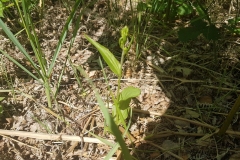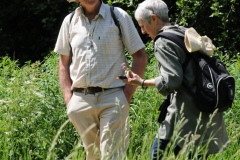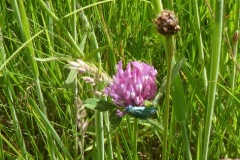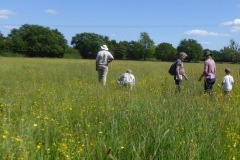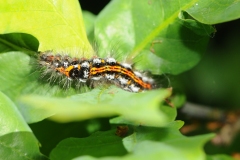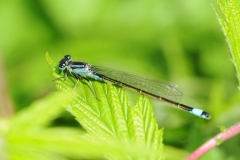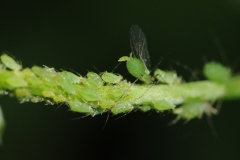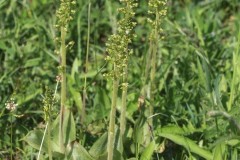Leaders : Joyce Simmons
Members Present :
Meet : 10.30am at the National Nature Reserve carpark to the west of Crowle village. Map ref: SE758140.
In glorious weather, calm, warm and sunny, 5 Doncaster Nats members (Tom, Jim Caroline, Paul and Joyce] had a very pleasant walk around Crowle Moor. Since it was sunny the threatened biting insects failed to appear, and only one tiny tick was detected on my light-coloured trousers.
We found the Dune Helleborines – around 20, although our count was not comprehensive, but there did seem fewer than our count of over 40 last year. However, none were actually in flower, although 2 were very close to having open flowers. They are a week or so later than last year.
Large Heath butterflies were very visible and obliging, posing for photos and flying slowly and near the ground so that they were easy to see. We didn’t actually count them, but certainly 30 or 40 were seen. Other insects were visible too. Day-flying moths, such as Mother Shipton and Brown Silver-lines were photographed or caught by Paul and seen close-up in a specimen tube. All were released unharmed of course.
Bees, hoverflies and particularly a good selection of dragonflies were seen. The most abundant were Common Blue and Large Red Damselflies.
Tom was not quite so lucky with plant galls. He only managed to find 8 species by lunchtime, which gave him the dilemma of delaying lunch – until he had fulfilled his ambition of 10 species before lunchtime. He waved his rule, but did eventually manage double figures, though he was surprised by how few he found.
We all enjoyed the walk, though it was getting rather too warm by the time we returned to the cars.
Joyce.
Leaders : Louise Hill & Les Coe
Members Present : Louise Hill, John Scott, Jim Burnett, Colin Howes, Geoff Carrick, Josephine Carrick, Anthony French, Les Coe, Lesley Bassett. Roger Shaw (guest).
Meet : Ryton Road, Anston car park 10.30am
Whilst the majority of the group explored the botanical offerings, two members concentrated on photographing the insect fauna that would stay still long enough for a photograph to be taken.
The weather was hot and sunny, with clear blue skies offering clear views of a circulating buzzard high overhead.
The first session before lunch was taken up with examining the area leading to and including the Little Stones area. The group then did, as many visitors have done before, partook of lunch whilst sitting on the rocky outcrops of the Little Stones.
During the afternoon visit to the flower meadow in the Stewardship field, we were informed of a large exotic butterfly by a couple that had managed to obtain a photo of it. The photo showed an image of a Blue Morpho, which had most likely escaped from the local butterfly farm. On descending into the wood, the party did come across this beautiful butterfly by the stream, but despite many approaches to photograph it, it all attempts failed and it flew away.
Whilst some members went to inspect the area in the wood containing a flush, other members were left behind to rest by the footbridge that crossed the stream. One member spotted a brown trout swimming back and forth under the bridge.
At the end of the day, whilst returning to the car park, I spotted a wood pigeon on a nest in a tree that was directly above the main footpath. There appeared to be two squabs in the nest.
Here is a selection of the insect fauna that was photographed, some of which still require identification.
Leaders : Anna Thirwell
Members Present :
Meet : Pinetree Farm, Sykehouse (SE628166)
The following list has been compiled from notes made by CAH.
It is likely that records logged by Louise Hill and fellow botanist/local farmer John Scott will contain many additions.
The traditionally pollarded white willows, so magnificent in the hedgerows and probably unique to this part of Yorkshire, are of particular interest and justify both ecological and landscape history studies.
The hay meadows demonstrate the classic linear wet-dry distribution of herbs in fields formerly managed as ‘ridge and furrow’. These examples would be worth special studies to examine and record this increasingly rare rural phenomenon.
Birds:
Blackbird; Buzzard; Carrion Crow; Chiffchaff; Jackdaw; Stock Dove; Willow Warbler; Wood Pigeon.
Mammals:
Mole (hills); Roe Deer (known to be present).
Insects:
Meadow Brown (1) Field 1; (1) Field 2.
Forrester Moth (2+) Field 1; (2+) Field 2; (3+) in front meadow.
Marmalade Hoverfly Episyrphus balteatus
Hoverfly Platycheirus albimanus
7-spot Ladybird Coccinella 7-punctata
Bumble Bees Bombus terrestris & B. lucorum
Click Beetle sp.
Spiders:
Tetragnatha extensa
Plants :
A = 1st Field. Hay meadow. Ridge & Furrow
B = Pond Area
C = 2nd Field. Hay Meadow. Ridge & Furrow
D = Front Meadow + tree planting
H = Hedgerow component
T = Tree-plamting in front meadow
| Botanical Name | Vernacular Name | A | B | C | D |
|---|---|---|---|---|---|
| Acer campestre | Field Maple | H | |||
| Alnus glutinosa | Alder | T | |||
| Alopecurus pratensis | Meadow Foxtail | * | * | * | |
| Anthoxanthum odoratum | Sweet Vernal Grass | * | * | ||
| Anthriscus sylvestris | Cow Parsley | * | * | * | |
| Arrhenatherum elatius | False Oat-grass | * | * | * | |
| Betula pendula | Silver Birch | T | |||
| Bromus mollis | Soft-brome | * | * | ||
| Cardamine pratense | Lady’s Smock | * | * | ||
| Carex pendula | Pendulous Sedge | * | |||
| Carpinus betulus | Hornbeam | T | |||
| Centaurea nigra | Common Knapweed | * | * | ||
| Cerastium fontanum | Common Mouse-ear | * | * | ||
| Cirsium arvense | Creeping Thistle | * | * | ||
| Crataegus monogyna | Hawthorn | H | H | ||
| Cynosurus cristatus | Created Dog’s-tail Grass | * | * | ||
| Dactylis glomerata | Cock’s-foot | * | * | ||
| Deschampsia cespitosa | Tufted Hair-grass | * | * | ||
| Epilobium hirsuitum | Great Willowherb | * | |||
| Festuca rubra | Red Fescue | * | * | ||
| Fraxinus excelsior | Ash | H | |||
| Hedera helix | Ivy | H | |||
| Heracleum sphondylium | Hogweed | * | * | ||
| Holcus lanatus | Yorkshire Fog | * | * | * | |
| Iris sp. [? pseudacorus] | Pale yellow variety like Yellow Flag | * | |||
| Juncus conglomeratus | Compact Rush | * | * | * | |
| Lathyrus pratensis | Meadow Vetchling | * | |||
| Leucanthemum vulgare | Ox-eye Daisy | * | * | ||
| Lolium perenne | Rye-grass | * | * | ||
| Lotus corniculatus | Bird’s-foot Trefoil | * | * | ||
| Luzula campestris | Field Wood-rush | * | |||
| Lychnis flos-coculi | Ragged-robin | * | |||
| Medicago lupulinus | Black Medick | * | * | ||
| Phleum pratense | Timothy | * | |||
| Plantago lanceolata | Ribwort Plantain | * | * | * | |
| Poa pratensis | Smooth Meadow-grass | * | * | * | |
| Poa trivialis | Rough Meadow-grass | * | |||
| Potentilla anserina | Silverweed | * | |||
| Prunella vulgaris | Selfheal | * | |||
| Prunus sp. | Cherry sp. | T | |||
| Prunus spinosa | Blackthorn | H | |||
| Quercus robur | Pedunculate Oak | H | T | ||
| Ranunculus acris | Meadow Buttercup | * | * | * | |
| Ranunculus repens | Creeping Buttercup | * | |||
| Rosa canina | Dog Rose | H | |||
| Rubus fruticosus | Bramble | H | H | ||
| Rumex acetosa | Sorrel | * | * | * | * |
| Rumex obtusifolius | Broad Dock | * | |||
| Rhynanthus minor | Yellow-rattle | * | |||
| Salix sp. | Willow sp. | T | |||
| Salix alba | White Willow | H | H | ||
| Sambucus nigra | Elder | H | |||
| Sanguisorba officinalis | Great Burnet | * | * | ||
| Solanum ducamara | Bittersweet | * | |||
| Stellaria graminea | Lesser Stitchwort | * | * | ||
| Stellaria holostea | Greater Stitchwort | * | |||
| Taraxacum officinalis | Dandelion | * | |||
| Trifolium pratensis | Red Clover | * | * | * | |
| Trifolium repens | White Clover | * | * | ||
| Urtica dioica | Stinging Nettle | * | * | ||
| Viburnum opulus | Guelder-rose | * | |||
| Vicia sativa | Common Vetch | * | * | ||
An update from Anna, 29th June.
This morning (9am, 29th June), walking through our meadows, it’s the first day this summer that it is alive with meadow browns and ringlet butterflies, not to mention the forester moths.
Leader : Colin Howes
Members Present : Colin Howes, Les Coe, Nora Boyle, Anthony French, Jim Burnett
Leader :
Members Present :
Meet :
The following list has been compiled from notes made by CAH.
Birds:
Blackbird; Chiffchaff; Chaffinch; Jackdaw; Rook; Wren
Insects
Marmalade Hoverfly Episyrphus balteatus
7-spot Ladybird Coccinella 7-punctata
Bumble bees Bombus terrestris & B. lucorum
Plants
Species highlighted in red are additional to the list published for Finningley Churchyard in ‘Doncaster’s Living Churchyards’ see Appendix 1.
It is likely that records logged by Louise Hill and John Scott will contain many additions.
A = East side of church
B = North side of church
C = West side of church
D = South side of church
E – Western extension
| Botanical Name | Vernacular Name | A | B | C | D | E |
|---|---|---|---|---|---|---|
| Acer pseudoplatanus | Sycamore (seedling) | * | ||||
| Achillea millefolium | Yarrow | * | * | |||
| Aegopodium podagraria | Ground Elder | * | ||||
| Alliaria petiolata | Jack-by-the-hedge | * | * | |||
| Alopecurus pratensis | Meadow Foxtail | * | ||||
| Anthoxanthum odoratum | Sweet Vernal Grass | * | * | * | * | * |
| Anthriscus sylvestris | Cow Parsley | * | * | * | ||
| Aquilegia vulgaris | Columbine | * | ||||
| Arrhenatherum elatius | False Oat-grass | * | ||||
| Bellis perennis | Daisy | * | * | * | ||
| Betula pendula | Silver Birch | * | ||||
| Bromus sterilis | Barren Brome | |||||
| Bryonia dioica | White Bryony | * | * | * | ||
| Buddleja davidii | Butterfly Bush | * | ||||
| Cardamine pratense | Lady’s Smock | * | * | |||
| Centaurea nigra | Common Knapweed | * | * | * | ||
| Cerastium fontanum | Common Mouse-ear | * | * | * | ||
| Chamerion angustifolium | Rose-bay Willow-herb | * | ||||
| Cirsium arvense | Creeping Thistle | * | ||||
| Clematis vitalba | Traveller’s -joy | * | ||||
| Conopodium majus | Pignut | * | ||||
| Convolvulus arvensis | Field Bindweed | * | * | * | ||
| Cornus sp. | Garden Dogwood | * | ||||
| Cotoneaster sp. | Cotoneaster sp. | * | ||||
| Cotoneaster horizontalis | Wall Cotoneaster | * | ||||
| Crataegus monogyna | Hawthorn | * | * | |||
| Dactylis glomerata | Cock’s-foot | * | * | * | ||
| Deschampsia flexuosa | Wavy Hair-grass | * | ||||
| Digitalis purpurea | Foxglove | * | ||||
| Epilobium hirsuitum | Great Willowherb | * | ||||
| Festuca rubra | Red Fescue | * | * | |||
| Galium aparine | Cleavers | * | * | * | ||
| Galium verum | Ladies Bedstraw | * | * | * | * | |
| Glechoma hederacea | Ground Ivy | * | ||||
| Geranium robertianum | Herb Robert | * | ||||
| Hedera helix | Ivy | * | * | * | ||
| Heracleum sphondylium | Hogweed | * | ||||
| Holcus lanatus | Yorkshire Fog | * | * | |||
| Holcus mollis | Creeping Soft-grass | * | ||||
| Hyacinthoides hispanica | Spanish Bluebell | * | ||||
| Hypochaeris radicata | Common Cat’s-ear | * | * | * | ||
| Ilex aquifolium | Holly | * | ||||
| Lamium album | White Dead Nettle | * | * | |||
| Lamium purpureum | Red Dead Nettle | * | ||||
| Leucanthemum vulgare | Ox-eye Daisy | * | * | * | ||
| Lonicera periclymenum | Honeysuckle | * | ||||
| Lotus corniculatus | Bird’s-eye-trefoil | * | * | |||
| Luzula campestris | Good Friday Grass | * | * | |||
| Malus domestica | Apple (Cultivated) | * | ||||
| Malva sylvestris | Common Mallow | * | ||||
| Medicago lupulinus | Black Medick | * | * | |||
| Myosotis arvensis | Field Forget-me-not | * | ||||
| Ornithogallum umbellatum | Star-of-Bethlehem | * | ||||
| Plantago lanceolata | Ribwort Plantain | * | * | * | * | |
| Plantago major | Rat-tail Plantain | * | ||||
| Poa annua | Annual Meadow-grass | * | ||||
| Poa pratensis | Smooth Meadow-grass | * | * | |||
| Poa trivialis | Rough Meadow-grass | * | * | |||
| Prunus sp | Cherry sp. | * | ||||
| Quercus robur | Pedunculate Oak | * | ||||
| Ranunculus acris | Meadow Buttercup | * | * | * | ||
| Ranunculus bulbosus | Bulbous Buttercup | * | * | * | ||
| Ranunculus repens | Creeping Buttercup | * | * | |||
| Ribes sanguineum | Flowering Currant | * | ||||
| Rosa canina | Dog Rose | * | ||||
| Rubus fruticosus | Bramble | * | * | |||
| Rumex acetosa | Sorrel | * | * | * | * | |
| Rumex obtusifolius | Broad Dock | * | * | |||
| Rhynanthus minor | Yellow-rattle | * | ||||
| Sambucus nigra | Elder | * | ||||
| Sanguisorba minor | Salad Burnet | * | ||||
| Senecio jacobea | Common Ragwort | * | * | * | * | |
| Silene dioica | Red Campion | * | * | |||
| Sisymbrium officinale | Hedge Mustard | * | ||||
| Sonchus oleraceous | Smooth Sow-thistle | * | ||||
| Sorbus aucuparia | Rowan | * | ||||
| Stachys sylvatica | Hedge Woundwort | * | ||||
| Stellaria holostea | Greater Stitchwort | * | ||||
| Stellaria media | Common Chickweed | * | * | |||
| Taraxacum officinalis | Dandelion | * | * | |||
| Taxus baccata | Yew | * | ||||
| Teucrium scorodonia | Wood Sage | * | ||||
| Trifolium pratensis | Red Clover | * | * | |||
| Trifolium repens | White Clover | * | * | |||
| Ulmus glabra | Wych Elm (suckering) | * | ||||
| Urtica dioica | Stinging Nettle | * | * | * | * | |
| Veronica chamaedrys | Germander Speedwell | * | * | * | * | |
| Veronica persica | Field Speedwell | * | * | |||
| Vicia hirsuta | Hairy Tare | * | * | |||
| Vicia sativa | Common Vetch | * | * | * |
Appendix 1
Plant species list for Finningley Churchyard from surveys undertaken by members of the Doncaster Naturalists’ Society 1994-1998 published in ‘Doncaster’s Living Churchyards’ Seccombe P.A. & Seccombe T. (1999). Doncaster Naturalists’ Society. Pp. 138.
Top Ten Churchyards in the Doncaster Region (Flowering plants and ferns)
| Parish | No of species |
|---|---|
| Owston | 108 |
| Finningley | 102 |
| Hooton Pagnell | 86 |
| Brodsworth | 84 |
| Burghwallis | 84 |
| Frickley | 83 |
| Rossington | 76 |
| Armthorpe | 73 |
| Bawtry | 73 |
| Arksey | 71 |
Survey Dates – 13th April 1994; 6th June 1994; Late July 1994; 14th March 1997; 20th March 1998
Recorders – Derek Allen; Darren Buxton; Frank Devine; Helen Devine; Thelma Dove; Ian Farmer; Kayleigh Farmer; Elizabeth Farningham; Trish Haigh; Tom Higginbottom; Andrew Hill; Louise Hill; Sheila Hill; Carol Hobart; Helen Kirk; Diana Robinson; Marc Secombe; Pip Secombe; Maurice Whitta
| Botanical Name | Vernacular Name | Notes |
|---|---|---|
| Acer pseudoplatanus | Sycamore | |
| Achillea millefolium | Yarrow | |
| Aegopodium podagraria | Ground Elder | |
| Agrostis capillaris | Common Bent-grass | |
| Alliaria petiolata | Jack-by-the-hedge | |
| Alopecurus pratensis | Meadow Foxtail | |
| Angelica sylvestris | Angelica | |
| Anthoxanthum odoratum | Sweet Vernal Grass | |
| Anthriscus sylvestris | Cow Parsley | |
| Aquilegia vulgaris | Columbine | |
| Armoracia rusticana | Horse Radish | |
| Arrhenatherum elatius | False Oat-grass | |
| Asplenium ruta-muraria | Wall Rue | |
| Bellis perennis | Daisy | |
| Bromus mollis | Soft Brome | |
| Bromus sterilis | Barren Brome | |
| Bryonia dioica | White Bryony | |
| Campanula rotundifolia | Harebell | |
| Capsella bursa-pastoris | Shepherd’s Purse | |
| Cardamine hirsuta | Hairy Bittercress | |
| Cardamine pratense | Lady’s Smock | |
| Centaurea nigra | Common Knapweed | |
| Cerastium fontanum | Common Mouse-ear | |
| Chamerion angustifolium | Rose-bay Willow-herb | |
| Cirsium arvense | Creeping Thistle | |
| Cirsium vulgare | Spear Thistle | |
| Conopodium majus | Pignut | |
| Convolvulus arvensis | Field Bindweed | |
| Cotoneaster sp. | Cotoneaster sp. | |
| Crataegus monogyna | Hawthorn | |
| Crepis capillaris | Smooth hawk’s-beard | |
| Dactylis glomerata | Cock’s-foot | |
| Elymus repens | Couch Grass | |
| Epilobium montanum | Broad-leaved Willowherb | |
| Erigeron canadensis | Canadian Fleablane | |
| Festuca rubra | Red Fescue | |
| Fraxinus excelsior | Ash | |
| Fumaria officinalis | Fumitory | |
| Galanthus nivalis | Snowdrop | |
| Galium aparine | Cleavers | |
| Galium verum | Ladies Bedstraw | |
| Glechoma hederacea | Ground Ivy | |
| Hedera helix | Ivy | |
| Heracleum sphondylium | Hogweed | |
| Hesperis matronalis | Dame’s Violet | |
| Holcus lanatus | Yorkshire Fog | |
| Hordeum murinum | Wall Barley | |
| Hypochaeris radicata | Common Cat’s-ear | |
| Ilex aquifolium | Holly | |
| Lamium album | White Dead Nettle | |
| Lamium purpureum | Red Dead Nettle | |
| Lapsana communis | Nipplewort | |
| Leucanthemum vulgare | Ox-eye Daisy | |
| Linaria vulgaris | Common Toadflax | |
| Lolium perenne | Rye Grass | |
| Luzula campestris | Good Friday Grass | |
| Malva sylvestris | Common Mallow | |
| Matricaria matricarioides | Pineapple Weed | |
| Medicago lupulinus | Black Medick | |
| Muscari neglectum | Grape Hyacinth | |
| Mycellis muralis | Wall Lettuce | |
| Plantago lanceolata | Ribwort Plantain | |
| Plantago major | Rat-tail Plantain | |
| Plantago media | Hoary Plantain | |
| Poa annua | Annual Meadow-grass | |
| Poa pratensis | Smooth Meadow-grass | |
| Poa trivialis | Rough Meadow-grass | |
| Polygonum aviculare | Knotgrass | |
| Polygonum persicaria | Persicaria | |
| Ranunculus acris | Meadow Buttercup | |
| Ranunculus bulbosus | Bulbous Buttercup | |
| Ranunculus repens | Creeping Buttercup | |
| Rubus fruticosus | Bramble | |
| Rumex acetosa | Sorrel | |
| Rumex obtusifolius | Broad Dock | |
| Sagina procumbens | Procumbent Pearlwort | |
| Sambucus nigra | Elder | |
| Sedum acre | Biting Stonecrop | |
| Sedum anglica | English Stonecrop | |
| Senecio jacobea | Common Ragwort | |
| Senecio vulgaris | Groundsel | |
| Silene alba | White Campion | |
| Sisymbrium officinale | Hedge Mustard | |
| Sonchus asper | Prickly Sow-thistle | |
| Sonchus oleraceous | Smooth Sow-thistle | |
| Stachys sylvatica | Hedge Woundwort | |
| Stellaria graminea | Lesser Stitchwort | |
| Stellaria media | Common Chickweed | |
| Tanacetum parthenium | Feverfew | |
| Taraxacum officinalis | Dandelion | |
| Teucrium scorodonia | Wood Sage | |
| Trifolium dubium | Common Yellow Trefoil | |
| Trifolium pratensis | Red Clover | |
| Trifolium repens | White Clover | |
| Tripleurospermum maritimum | Scentless Mayweed | |
| Urtica dioica | Stinging Nettle | |
| Veronica arvensis | Wall Speedwell | |
| Veronica chamaedrys | Germander Speedwell | |
| Veronica hederifolia | Ivy-leaved Speedwell | |
| Veronica persica | Field Speedwell | |
| Vicia sativa | Common Vetch | |
| Viola sp. | Violet sp. |
Leader : Joyce Simmons
Members Present :
Leader : Jim Burnett
Members Present : June Birchill, Jim Burnett, Anne Davis, Paul Davis, Tony Finch, Tom Higginbottom, Colin Howes, John Neep, John Scott.
Meet : 10am in public car park at Langold Lake
Dyscarr Wood is a Notting Wildlife Reserve, Small parts of it cross the county boundary into Yorkshire and so into VC 63. The information board at the public entrance to the site mentions that hawfinch and all three woodpeckers are present, but none were seen on this visit. We also failed to find any fly orchids, which were also mentioned on the notice board.
Much of the time was spent in two flower filled meadows next to the wood, which provided common twayblade, southern marsh orchids and common spotted orchids (plus vigorous hybrids between the last two mentioned (probably)).
On a subsequent visit0n the 13th June, dozens of common spotted orchids had appeared.
The wood itself produced early purple orchids still in flower, woodruff, sanicle, violets, bluebells, ransoms, yellow archangels, dog’s mercury, arums, ground ivy, celandines and carpets of wood anemones, but the blooms were now fading away.
Much of the wood is rather wet, with many natural springs (the clue is in the name), while a small pond had marsh marigolds, yellow iris and greater pond sedge. The newts seen on previous visits in the pond, failed to show up for this visit.
Jim Burnett.



